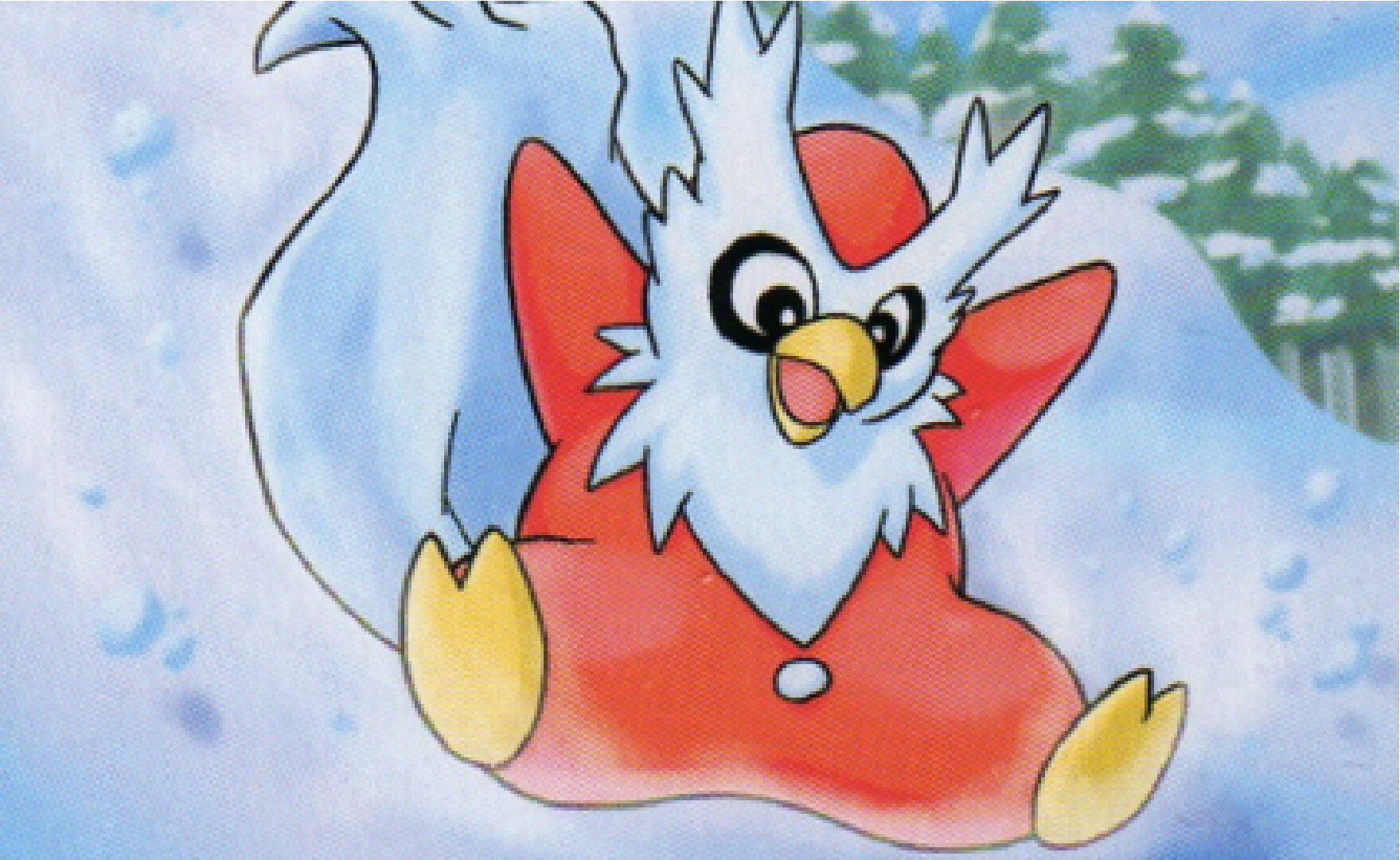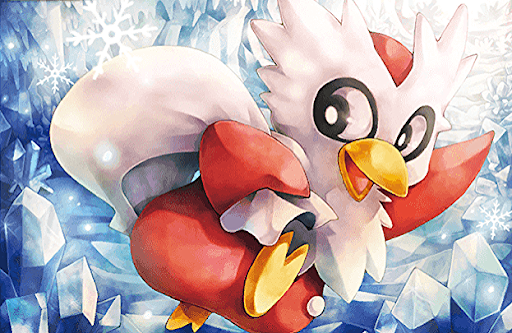Dex Dive: Delibird
Dex Dive is a brand-new series of ongoing articles that could be popping up on Unsupervised Nerds every now and then. It is all about exploring the lore behind a single Pokemon, or possibly even a whole evolution line. Each post will not only look at the universe of the series, but also to the real-world lore that went into the creation of the Pokemon.
Given that we are currently hitting the apex of the holiday season, our first ever Dex Dive will be spent looking into the most Christmasy Pokemon of all, Delibird.
(Because some day the Pokedex section will become out of date, for future reference this goes only as far as Generation VIII)
Basics
Delibird: Delivery Pokemon
#225
Type: Ice, Flying
Height: 2’11” / 0.9m
Weight: 35.3 lbs / 16 kg
Pokedex Entries
Delibird is part of Pokemon’s Generation II, first appearing in the games Gold, Silver, and Crystal. The Pokedex entries from these games mainly tell us about the way Delibird interacts with food, including the fact that they always carrying its food wherever they go.
There are stories of how Delibirds have shared their food in times where they have come across someone lost and starving; conversely, if a Delibird is attacked, they have been known to throw their food at the opponent.
Silver’s entry even gives the reason why Delibird is always carrying their food: they nest on sharp cliffs and are carrying the food to bring to their chicks. So, anytime one of these Pokemon save a person, or try to defend themselves, they are using up the food that they are attempting to bring to their babies.
From Generations III to VI, and even Generation VIII, there is little in terms of new information, but it makes up for this by adding to the level of specificity to these previous entries. It is in Ruby and Sapphire that there is first brought up that Delibird carries all this food in their tails. I’m sure there are other people who believed that it is just a bag in Delibird’s hand, but no, it is a hollow, seemingly stretchy, tail that they fill with food.
In the same games it also comes out that the stories of Delibird saving starving lost people come from helping a famous explorer who reached the peak of Mt. Everest. By Alpha Sapphire this same Pokedex entry comes up again, although this time they remove the reference to Mt. Everest, instead calling it “the word’s highest mountain”, presumably to not have Mt. Everest canon in the Pokemon world. Other entries generalize this even further by saying that Delibird has a habit of sharing food with people lost in mountains. This all fits the idea that Delibirds make their nests on cliffs, and so it makes sense that it would be on mountains that they are most known for helping travelers.
It is only in Generation VII that the Pokedex has something new to say about Delibird, presumably because these games took place on a series of tropical islands, and this ice type Pokemon has been only talked about in terms of being high up in mountains. In Sun they explain just this by stating that Delibirds in Alola can withstand heat “to a certain extent”.
The Generation VII games also give more context to past entries. Delibird is written as being generous with sharing food with both people and Pokemon, which is a first time there is mention of sharing with Pokemon as well. The entry goes on to say that because of this, Delibird is always scrounging for more food. This makes it sound like a day in the life of Delibird is going out to find food for their chicks, but constantly wanting to be kind of those they meet along the way, especially when they meet those in need. They share what they have, and then need to search out more to make up for it.
We also get an insight into what this food actually is when it is written that Delibird is an omnivorous, and sometimes gives people bug Pokemon to eat. That’s right, some of the “food” Delibird is keeping in its tail is bug Pokemon.
Speaking of that tail full of bugs, it turns out that the Delibird with the largest tail is the leader of their flock. This is the first time it is brought up that these Pokemon keep in flocks, and really brings in an interesting dynamic with how they work. With the way Delibird is so known for sharing, this seems to imply that the Delibird held in highest regard is the one with seemingly the most to give, an idea that seems incredibly kind.
To round this out, there is one final entry to look at, shown in the Pokemon anime. In the episode, Ash’s Pokedex explains that Delibird’s most unique attack is giving presents. This is something that matches up with one of the original entries, where throwing food is said to be their attack. By the end, it says that these presents can restore energy to the opponent, which, again, adds up with the idea of throwing food. But in the middle, it gets a little weird: the Pokedex says that “some of these presents have been known to explode”.
This seems to imply one of two things: either some of what Delibird considers food is actually explosive, or they keep explosives in the same place as they keep their food. Thanks to Ultra Sun, we know that Delibird eats bug Pokemon, and there is at least one bug Pokemon who naturally learns self-destruct, Pineco. This could mean that Delibirds use such Pokemon as their explosive food, though it doesn’t rule out the possibility that they are going around with some form of explosive that they don’t consider food.
So, next time you run into a wild Delibird, keep in mind that if left alone, they are only looking to help people, and bring food home to their chicks. And if you catch one, not only are you preventing this, but you may also be catching all the bug Pokemon they have stored in their tails.
Creative Origins
Name:
Delibird is a named derived as a portmanteau of “deliver” and “bird”, describing it fairly aptly. As an added bonus, the way it is meant to be pronounced has Delibird sound like “delivered” but with the “v” swapped for a “b”.
Aesthetics:
Delibird has two main aesthetic influences: a penguin and Santa Claus.
The basic body shape of Delibird is a penguin. The very upright body-type, with the flipper-like wings and short beak, is all very representative of one. Interestingly enough, though this Pokemon is based off a penguin, a flightless bird, it can still learn fly.
When getting up to the feathery mask shape present over Delibird’s face, the choice becomes more specifically a rockhopper penguin. Rockhopper penguins tend to have long yellow feathers coming out just above their eyes, giving almost the impression of insane eyebrows. While Delibird’s white feathers cover much more of its face, taking away from them looking so eyebrow-like, the idea is still maintained.
The rest of Delibird comes from Santa Claus. Immediately the most obvious demonstrations of this are its wider body and its colouring. Delibird is coloured in a way that gives off the impression of being in a large red suit, complete with a white button in the middle of its belly. And while the top feathers around its face give off rockhopper penguin vibes, the bottom half takes on the appearance of Santa’s big white beard.
Then there is Delibird’s tail. While penguins have tails, they are relatively short and pointed. Delibird’s tail is instead based more specifically on Santa’s bag of presents, so much so that in much of the art for this Pokemon it is hard to tell that it isn’t just a bag. It is only from particular angles that it becomes apparent that this bag is actually connected to Delibird.
Mythology:
The mythological origins of Delibird seem to be relatively light, and entirely based off Santa Claus. The giving nature of this Pokemon, and the way it stores its gifts (in this case, food) in its large bag-like tail, all stem from this source.
The added detail with Delibird that the food it shares was meant for its own babies does create a harsh image with its Santa Claus qualities though, calling to mind the idea that Santa handing out gifts meant for his own children when he hands them out to everyone else on Christmas. Not that Delibird’s lore actually affects Santa’s in this way.
There are also various spirits and gods across many mythologies who help lost travelers, which is a big part of Delibird’s Pokedex entries. The fact that Delibird is specifically called out as having saved a lost traveler from starving as they climbed the tallest mountain seems like something that could have come out of these myths. But, in the research done for this there were too many mythological figures that fit in with helping lost travelers, with none seeming like quite the right match. Though, if you know of such a mountain spirit or any such being, please put it into the comments.







